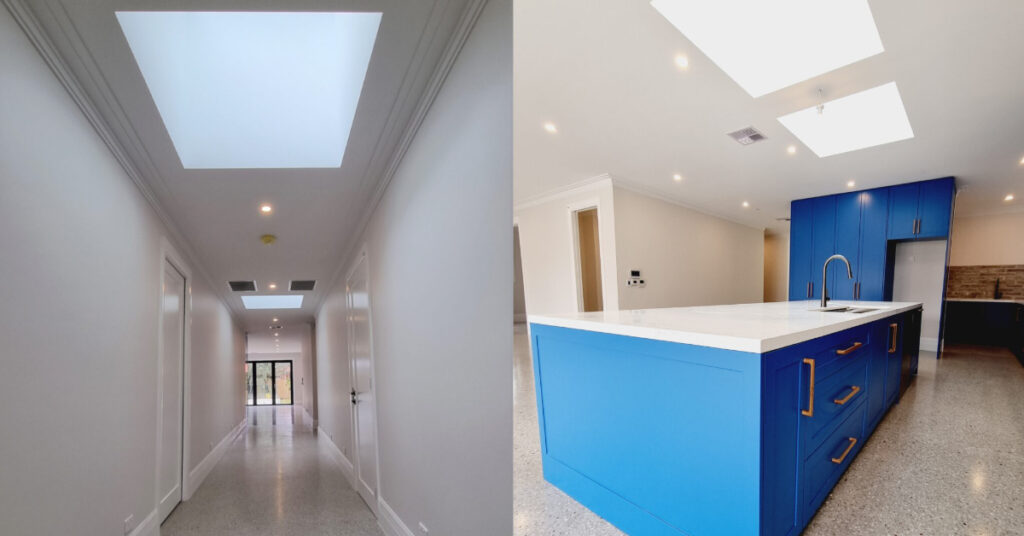
Skylights have been added to buildings since the invention of glass. Many public and commercial buildings incorporate skylights into the very architecture of the building. Skylight architecture is prominent throughout the modern world – and widely adopted even for residential applications.
Homeowners often consider skylights when they want to improve their home’s energy efficiency or add more natural light. Builders often incorporate skylights into the home to create an ambience of luxury and sophistication. Apart from bathing rooms in natural light, skylights also have many financial benefits. They can help reduce your energy bill, increase the value of your home, and improve your home’s appearance.
Skylights can be used in any room and can be customised to fit any space. There are two main types of skylights: fixed and operable. Fixed skylights are the most popular type, as they are the least expensive and are easy to install. Operable skylights, on the other hand, can be opened and closed, making them ideal for ventilation.
If you’re looking for a top-of-the-line skylight, Vivid Skylights is the way to go. We offer a variety of skylight options to suit your needs, and our team is passionate about helping you find the perfect skylight for your home. Our fixed and operable skylights come in laminated glass, which is a type of safety glass that is made up of at least two layers of glass with a plastic interlayer bonding them together. Laminated glass is less likely to shatter than regular glass.
We also offer a 5-year warranty on all of our products, ensuring that your investment is protected. We use only the highest quality materials and our skylight products are backed by a team of experts. Vivid Skylights’ products are designed to provide years of trouble-free service.
What Types of Skylights Are Used in Architecture?
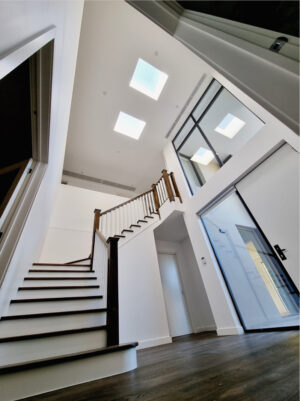
There are different types of skylight in architecture based on their function and design, and they can be used in both residential and commercial properties.
Tubular skylights are the most common type of skylight design in architecture. They consist of a dome-shaped lens that captures sunlight and directs it down a tube to the room below. Tubular skylights are available in a variety of sizes, from 10-inch diameter tubes to large 21-inch diameter tubes.
Another common type of skylight architecture is the pyramid skylight, which has a glass pyramid on the roof with a metal frame. Pyramid skylights are more expensive than tubular skylights, but they offer better ventilation and a more aesthetically pleasing look.
Dome skylights are also a popular option because they allow for maximum light transmission. This type of skylight architecture has details that are commonly used in commercial buildings. They are named for their dome-like shape and are made of either glass or acrylic. Its architecture is designed to evenly distribute light throughout a space, which is vital for large and open commercial areas.
What Is a Skylight in a Building?
You might ask, “What is a skylight in a building?” By textbook definition, a skylight is a window commonly built on a roof or ceiling and used to admit natural light into a building. However, electric skylights are becoming increasingly popular as an alternative to traditional skylights. While electric skylights may have some benefits, they are not true skylights.
A true skylight is made up of glass or acrylic that is placed in a frame and sealed to create a watertight and weatherproof seal. The frame is then installed in an opening in the roof or ceiling. Electric skylights, on the other hand, are simply plastic or acrylic domes that are placed on the roof or ceiling and wired to provide light.
While electric skylights may be less expensive than traditional skylights, they are not as durable or energy efficient.
What Are the Different Types of Skylights?
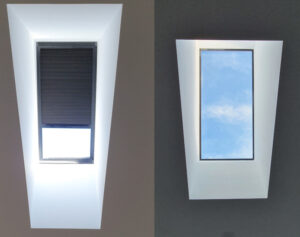
There are two different types of skylights: fixed and operable. Fixed skylights are permanently installed on your roof and don’t open or close. Operable skylights have a movable panel that can be opened to let fresh air and natural light into your home. Many builders incorporate skylights into the architecture of a home from the inception of its design.
Vivid Skylights’ fixed skylights are perfect for homeowners who want to enjoy natural light without having to worry about maintenance. Fixed skylights are sealed and cannot be opened, so they require no maintenance other than occasional cleaning. They are also less likely to leak than skylights that can be opened and closed. Fixed skylights are a great way to add natural light to your home without any hassle.
Our operable skylights are the perfect solution for homeowners who want to bring natural light into their homes and improve ventilation at the same time. They are easy to install and can be opened and closed to control the amount of light that comes in. Operable skylights are a great way to save on energy costs, as they help to keep your home cooler in the summer and warmer in the winter.
Vivid Skylights offers a wide range of skylights, including fixed and electric models, that come in a strong aluminium frame with a black powder-coated finish. You can rest assured of our products’ durability.
Skylight Design Considerations
When it comes to skylight design, there are a few things to consider to get the best results. You need to think about the orientation of the skylight and how it fits within the architecture of a building. It should be placed so that it will get the most sunlight possible. You also have to take into account the size of the space that you want to add a skylight to. The larger the space, the more light you will need.
In addition, you have to decide whether to install a fixed or operable skylight in your home. Think about how often you would like to open your skylight. If you live in an area with a lot of pollen or other airborne allergens, you may want to choose an operable skylight so that you can open it up for ventilation on days when the air is particularly clear.
Fixed skylights are best suited for areas that don’t get a lot of sunlight and don’t need as much ventilation, such as hallways and stairwells. They are also a good choice if you’re looking for a low-maintenance option. Unlike operable skylights, which need to be regularly cleaned and maintained, fixed skylights require little upkeep.
Operable skylights are more suited for kitchens and bathrooms because they provide natural ventilation. They can be installed on the roof or in the ceiling, and come with a variety of features, such as remote control operation and rain sensors.
Skylight Materials for Residential Construction
There are a variety of skylight materials available for residential construction and commercial architecture. Skylights can be made from glass, plastic, metal, or fibreglass. Some skylights are even made from recycled materials. The type of skylight material you choose will depend on the climate you live in, the amount of sunlight you want to let in, and your budget.
Vivid Skylights is one of the top manufacturers of skylights in Melbourne, and our products feature laminated glass for added strength and durability. Our skylights also come with aluminium frames, making them corrosion-resistant and long-lasting investments. You can trust that you’re getting a quality product when you choose Vivid Skylights.
Skylight Case Study
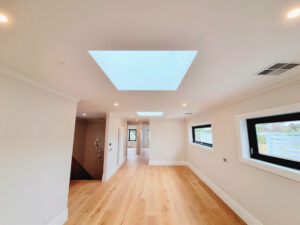
A skylight can brighten up any room. Our clients have enjoyed the added natural light in their homes and have found that it’s made a big difference in their overall mood and energy levels.
We often receive positive feedback about skylight installations. They often say things like: “Once installed the skylight, our home feels so much more open and airy. The natural light is such a nice change from the artificial lighting we were used to, and it’s helped improve our moods. We feel more productive during the day and sleep better at night.”
Other clients tell us how they “love how the skylight brings the outdoors inside.” They enjoyed the feeling of being closer to nature even when they were indoors. “And on sunny days, it’s like having a personal sun in the house!”
In another skylight case study, a family in Melbourne saw a significant drop in their energy bill after installing two skylights. The skylights not only added natural light to the home, but they also helped to keep the home cooler in the summer months. Adding skylights as a part of the architecture of a passive solar home can really pay off.
Make sure to check out our skylight gallery for more inspiration. We’ve collected a range of skylight photos that showcase the beauty and versatility of skylights, so you can get an idea of what they might look like in your own home. From simple and elegant skylights to more complex and intricate designs, there’s something for every homeowner.
Common Skylight Questions Relating to Skylight Design
Skylights are a popular design element in today’s homes. Here are some common skylight questions to help you narrow down your options and choose the best skylight for your home.
Skylight Construction - What Goes Into a Skylight?
There are a few key things to keep in mind when it comes to skylight construction. First, the skylight should be installed by a professional with experience in skylight installation. Second, it should be properly sealed and weatherproofed to prevent leaks. Third, the skylight has to be properly ventilated to prevent condensation and moisture buildup.
It is also important to know that the size and shape of a skylight can vary greatly depending on the specific needs of the home or building. For example, a small rectangular skylight may be placed over a kitchen sink while a larger circular skylight may be installed in a living room or bedroom. The type of glass or material used for the skylight must also be considered.
What Is the Purpose of a Skylight?
The purpose of a skylight is to bring natural light into a home. This is beneficial for two reasons: it can help reduce energy costs by reducing the need for artificial lighting, and it can also improve the mood of occupants by increasing the amount of daylight exposure. Additionally, skylights can add value to a home by enhancing its architecture and character from the inside and out.
Why Use a Skylight?
A lot of people may be wondering “Why use a skylight?” when you can use artificial lighting. Well, there are several reasons why property owners might want to install a skylight aside from increasing their home’s value.
Skylights can improve your indoor air quality. By allowing fresh air into your home, you can help to reduce the level of pollutants and allergens in the air. This can be especially beneficial for people who suffer from asthma or allergies.
In addition, exposure to natural light has been linked to a number of health benefits, including improved mood and increased vitamin D levels.
What Are the Advantages and Disadvantages of a Skylight?
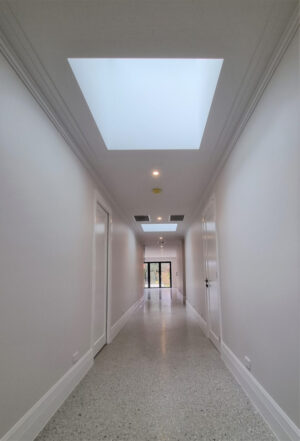
Before you have a skylight installed in your home, it is important to weigh the pros and cons of skylights.
One of the main advantages of a skylight is that it can help reduce your energy bills. Adding skylights as part of the architecture of a home, taking advantage of passive solar principals, skylights allow natural sunlight to enter your home, which can help heat your home during the winter months. You can also open your skylights in the summer to help ventilate and cool your home.
They can also improve the quality of light in your home. Skylights can help reduce glare and provide a softer, more natural light. This type of lighting is especially beneficial for people who suffer from the seasonal affective disorder (SAD).
However, you might also experience several disadvantages of a skylight. They can leak and let water in, causing damage to the surrounding area if not installed properly. But it is worth noting that while it’s true that skylights are more susceptible to leaks than traditional windows, this is usually due to poor installation or maintenance. When properly installed and maintained, skylights are no more likely to leak than any other type of window.
Skylight Systems in Melbourne by Vivid Skylights
If you’re looking for a way to add some extra light to your home, then you might want to consider skylight systems from Vivid Skylights. Based in Melbourne, the company specialises in skylight sales and installation.
We have a wide range of products available for sale in our skylight store, including both traditional and modern designs. We also offer a skylight installation service, which can be used to install skylights as part of the architecture of new buildings or in existing buildings.
Vivid Skylights’ website includes many helpful resources, such as our skylight gallery and skylight installation guide. Make sure to check these out for more inspiration and tips on how to get the most out of your skylight system.
All of our high-quality skylight systems come with a 5-year warranty. Vivid Skylights is committed to providing customers with the best possible products and services. Contact us today to learn more about our skylight systems and how they can benefit you.
